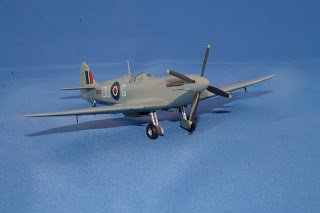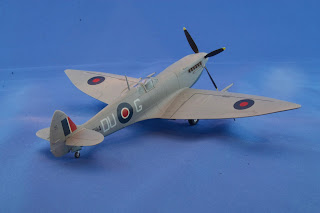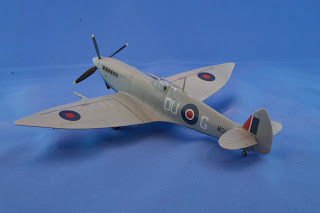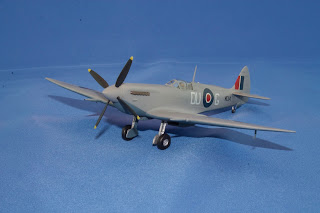Spitfire HF VII, MD114/DUoG, No 312 (Czechoslovak) Squadron, RAF, Skeabrae, 1943.
I hadn’t yet built a Hasegawa Spitfire, and since I didn’t yet have a Mk VII on my shelf decided I’d do this one.
The Subject
I’ve come to understand that frontline squadrons would rotate on occasion to airfields in the North and East, but would trade their aircraft for similar ones at the new bases. The point was to give them some rest while continuing to operate but at a much reduced threat level. One example is No. 312 Squadron, which took a break in June 1943 from operations on the Channel flying from Church Stanton, Somerset with 10 Group to 13 Group flying from Skeabrae, Orkney. They traded their mounts from the Spitfire Vc to the Spitfire HF VII. When their break was done in December 1943 they transitioned to the LF IX. They remained on the Mk IX until the end of the war, transferring to Czechoslovakia in September, 1945.
The HF Mk VII was a pressurized design, similar to its sister the unpressurized F Mk VIII. It had all the refinements of the F Mk V including the improvements developed in the F Mk III. These included a 60 series Merlin, retractable tail wheel, internally armored windscreen, blown canopy and improved landing gear. Additionally, the VII/VIII development included greater internal fuel and included the Mk XII rudder (broad chord) on most deliveries.
Development of the HF Mk VII and F Mk VIII was delayed
The Model
Accuracy issues aside, this is a very easy kit to build. Within the first few hours I had a wing together and the fuselage assembled with cockpit installed. Filler was required at the wingtip extensions as well as the wing-to-fuselage joints forward and aft; the fillets fitting near perfectly with a very light run of a sanding stick. I don’t like how the aft wing underside joins the fuselage, being an insert with nothing to support it. In my case, even with a large piece of plastic to “hold” it flush it was still a bit off and required filling.
Painting was very easy, the scheme I chose for my first foray into the VII is a simple one of Medium Sea Grey (Tamiya XF83) on the topsides over a PRU Blue (Tamiya mix of 3 parts XF-18 + 1 part XF-2) on the undersides. The High Altitude Scheme. Decals are from the AZModel kit as I did not like my choices in the kit boxing.
Ok, to accuracy. The Hasegawa late Merlin Spitfires are all the same sprues and so Hasegawa made some compromises in order to have 1 set of sprues cover the HF VII, F/HF VIII, and early F/LF IX. They have you fill aileron panel lines to make either the short VII/VIII version, or the IX version. The wing doesn’t have the panel lines for the fuel tanks on the VII/VIII but then again these were puttied and smoothed then painted, so should not be visible anyway. Shape-wise, the wing is spot-on in span but a little long in chord by about 1.5-1.8 mm.
The fuselage is a bit more off. The nose is short by 1.7mm over a distance of only 26mm, making in noticeably short. The rest of the fuselage, from the firewall to the rudder post, is short by 2.5mm.
Summary
Overall a very easy kit to build. Similar to building a Tamiya Spitfire in terms of ease…but also in terms of being slightly off. Of course, every kit is off just a bit as none are yet perfect. Being such an easy build I’d certainly recommend it if one does not insist on perfect accuracy.
Thanks for looking…




